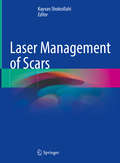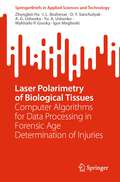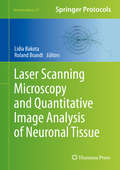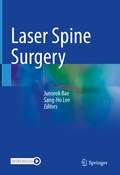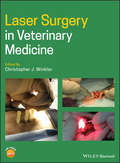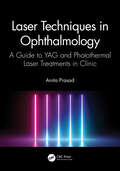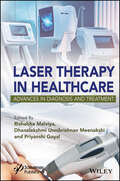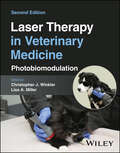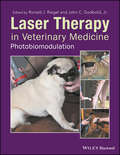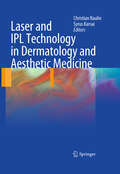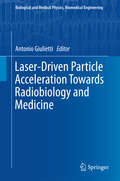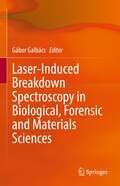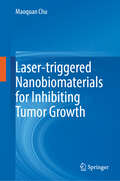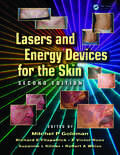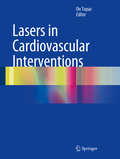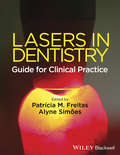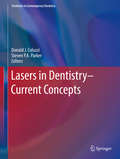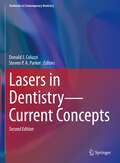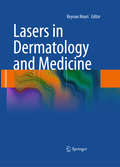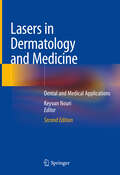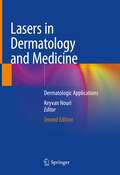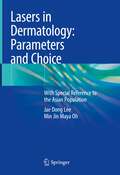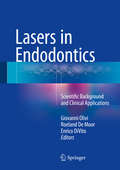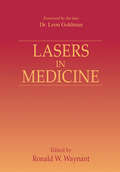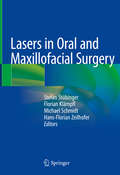- Table View
- List View
Laser Management of Scars
by Kayvan ShokrollahiThis book addresses the management of scars using lasers and light. The authors provide a comprehensive overview of the current laser modalities and the science and evidence behind them. They also present various treatments, including those using carbon dioxide lasers, Erbium:YAG lasers, pulsed dye lasers and Q-switched lasers. The book includes detailed information on the treatment of burn, acne, keloid and hypertrophic scars, as well as discussions of the complications of laser treatments and ethical and medico-legal issues. Scars have many causes, including trauma and burns, but also medical treatments themselves - scars are an inevitable consequence of most surgery. There have been significant advances in laser and light technology over the last decade, and the management of scars with a variety of lasers has been adopted both in traditional healthcare settings and in the cosmetic sector. Edited by a respected burns and plastic surgeon, this book is a valuable resource for a variety of clinicians including dermatologists, laser practitioners, physiotherapists and occupational therapists, burn care professionals, as well as multidisciplinary teams working with patients with scars of all aetiologies.
Laser Polarimetry of Biological Tissues: Computer Algorithms for Data Processing in Forensic Age Determination of Injuries (SpringerBriefs in Applied Sciences and Technology)
by A. G. Ushenko Yu. A. Ushenko Igor Meglinski Zhengbin Hu I.L. Bezhenar O.Y. Vanchulyak Mykhailo P. GorskyThis book highlights the results of numerical computer-aided smart methods as part of a comprehensive statistical, correlated, and fractal analysis of laser polarimetry. It includes a comprehensive approach to differentiation of lifelong or postmortem origin of injuries and determination of their antiquity based on the analysis of statistical and spatiotemporal frequency evolution of photometric, polarization, and phase parameters of laser images of histological sections of the skin of biomannequins. It discusses the relationship between the coordinate distributions of the intensity of laser images from skin tissues of biomannequins and the nature of its damage. It presents the analysis of relationships between changes in the mean and variance of coordinate distributions of azimuths and ellipticity of polarization images of histological skin sections and the time intervals after injury. Complex differentiation of lifelong and postmortem skin injuries of biomannequins and establishment of their time intervals throughout the entire monitoring interval of changes in the mean and variance of coordinate distributions of phase shifts between orthogonal components of the amplitude of laser images of a series of corresponding histological sections are also presented in this book.
Laser Scanning Microscopy and Quantitative Image Analysis of Neuronal Tissue
by Lidia Bakota Roland BrandtLaser Scanning Microscopy and Quantitative Image Analysis of Neuronal Tissue brings together contributions from research institutions around the world covering pioneering applications in laser scanning microscopy and quantitative image analysis and providing information about the power and limitations of this quickly developing field. This detailed volume seeks to introduce key questions, to provide detailed information on how to acquire data by laser-scanning microscopy, and to examine how to use the often huge digital data set in an efficient manner to extract maximum information. Thus the book not only provides a compilation of diverse protocols but aims to bring together biological bench work, laser scanning microscopy, and mathematical, computer-assisted data analysis to grasp novel insights of form, dynamics, and interactions of microscopy-sized biological objects. Written in the popular Neuromethods series format, chapters include the kind of practical implementation advice that promises successful results. Wide-ranging and innovative, Laser Scanning Microscopy and Quantitative Image Analysis of Neuronal Tissue will stimulate the reader to make efficient use of the application of laser scanning microscopy for his or her own research question.
Laser Spine Surgery
by Sang-Ho Lee Junseok BaeThis book describes and illustrates state-of-the-art techniques in laser spine surgery. Laser technology has revolutionized surgeries in many specialties to perform minimally invasive and cutting-edge procedures. Recent advances in spinal surgery have led to the increasingly widespread use of minimally invasive techniques based on endoscopy and microscopy. Nevertheless, the application of laser in the context of spinal surgery remains less well known, and the aim of this book is to present practical usage of laser in spine surgery to our readers. A wide variety of minimally invasive approaches to spine surgery using CO2, Ho: YAG, and Nd: YAG lasers are presented in detail, with a discussion of equipment and specific recommendations on laser settings. Care has been taken to ensure that the content is faithful to the fundamental principles of spine surgery and evidence-based medicine. The book will be an essential resource for all who use or are intending to use lasers in spine surgery.
Laser Surgery in Veterinary Medicine
by Christopher J. WinklerThis book is a state-of-the-art reference to using surgical lasers to treat animal patients. Encompassing theory and practice, it emphasizes procedures, techniques, and equipment, with specific recommendations for laser settings. While most of the procedures emphasize surgeries on dogs and cats, this practical guide also dedicates chapters to equine, small mammal, avian, aquatic animal, and reptile surgeries, making it an excellent clinical reference for any busy veterinarian. The book begins with background information on the theory and science of laser surgery, then details specific surgical procedures with step-by-step instructions and accompanying photographs. The next section provides practical guidance for incorporating lasers into the veterinary practice, and the final section offers a look at the future of lasers in veterinary medicine and surgery. A companion website features video clips of surgery procedures. Presents a state-of-the-art guide to using laser surgery in veterinary practice, from theory and procedures to techniques and equipment Focuses on dogs and cats, including specialties such as ophthalmic laser surgery, laser neurosurgery, and photodynamic therapy, with chapters on equine, small mammal, avian, aquatic animal, and reptile surgeries Draws on the experience of more than 20 experts in various areas Provides practical advice for incorporating laser surgery into the veterinary practice, with the heart of the book devoted to specific surgical procedures Includes specific recommendations for laser settings and techniques for the procedures discussed Offers video clips demonstrating surgical techniques on a companion website Laser Surgery in Veterinary Medicine is an essential resource for anyone using surgical lasers in veterinary medicine, including veterinary students, practitioners, and specialists.
Laser Techniques in Ophthalmology: A Guide to YAG and Photothermal Laser Treatments in Clinic
by Anita PrasadThis is a practical guide to using lasers in the Eye clinic and includes all commonly performed Lasers for a range of ocular conditions. It uses multiple illustrations of real-life fundus photographs, FFA images, OCT images and digitally modified retinal images to simplify learning the fundamentals of laser physics and physiology, laser safety and an overview of the variety of ophthalmic lasers in current use. It standardizes Laser procedures and serves as a reference guide for Ophthalmic trainees learning the technique that can be transferred to their clinical practice. The book simplifies understanding of Ophthalmic Lasers and answers common questions of how and why things are done. Key Features • Emphasizes on Nd-YAG Laser, Lasers in Glaucoma and Photothermal Lasers for Retinal Pathology, with clarity on techniques and pearls on dealing with common laser related issues that come with experience.• Provides content in a Q&A format which is ideal as a lesson from trainer to trainee and answers all the doubts and laser related questions a trainee may have and aids their learning and progression to performing Lasers safely and independently.• Uses digitally modified images with bullet points and reference text boxes, making the content user friendly and easy to understand.
Laser Therapy in Healthcare: Advances in Diagnosis and Treatment
by Rishabha Malviya Priyanshi Goyal Dhanalekshmi Unnikrishnan MeenakshiThe book explores the intersection of laser technology and healthcare, highlighting its applications, challenges, and potential future in medical practice. Implementing cutting-edge technologies has upended the paradigms of diagnosis and treatment in the ever-changing world of healthcare. Among these breakthroughs, the introduction of laser therapy stands out as a transformative moment, presenting a tremendous range of possibilities across a wide range of medical areas. This book is the outcome of considerable research, combined experience, and a passionate study of lasers’ diverse uses in modern medicine. This thorough book navigates the complex field of laser physics, clinical applications, and novel treatment interventions that are transforming the healthcare sector. This book acts as a roadmap through the various aspects of laser-based diagnostics and treatment modalities, from the basic chapters that explain the fundamentals of laser physics and its significant effects on tissues to the in-depth investigation of laser surgery in modern healthcare, including a variety of medical operations, such as brain surgery, cardiovascular procedures, dermatology, and oral surgery. Each chapter focuses on a different aspect of laser therapy, emphasizing its critical role in the treatment of many medical problems, from neurological disorders to oncology, dentistry, wound healing, and more. The book also includes an in-depth discussion of laser therapy’s classification, processes, clinical uses, and safety considerations. Audience The book is intended for researchers, scientists, medical specialists, and industry engineers in various disciplines including biomedical sciences, biotechnology, microbiology, biochemistry, immunology, pharmacy and pharmaceutical sciences, bioinformatics, translational research, oncology, medical sciences.
Laser Therapy in Veterinary Medicine: Photobiomodulation
by Christopher J. Winkler Lisa A. MillerA comprehensive, up-to-date reference to the clinical applications of lasers in veterinary practice Laser Therapy in Veterinary Medicine: Photobiomodulation, Second Edition is a fully revised and expanded text focusing on therapeutic lasers in veterinary practice. Emphasizing clinical applications for therapeutic lasers, the book is a comprehensive resource for all aspects of laser therapy in dogs, cats, horses, food animals, and exotics. The Second Edition has been updated throughout to reflect advances and new information, with expanded coverage on dosing and new information on the use of photobiomodulation in oncology and urinary conditions. The book begins with introductory chapters on the history, theory, science, and safe use of laser therapy, with the majority of the book devoted to practical applications. The Second Edition: Offers a comprehensive reference to all aspects of using therapeutic lasers in veterinary practice Emphasizes the clinical applications of laser therapy, with procedures and strategies for the clinical setting Covers laser use in dogs, cats, horses, food animals, and exotic species Fully updated throughout to reflect advances in the field, with new information on digital thermal imaging, uses in oncology, and dosing revisions Features clinical photographs, radiographs, line drawings, and graphs to support the text Laser Therapy in Veterinary Medicine is an essential resource for veterinary practitioners, specialists, and students interested in using therapeutic lasers to treat veterinary patients.
Laser Therapy in Veterinary Medicine: Photobiomodulation
by John C. Godbold Jr. Ronald J. RiegelLaser Therapy in Veterinary Medicine: Photobiomodulation is a complete guide to using therapeutic lasers to treat veterinary patients, focusing on practical information. Offers a comprehensive resource for incorporating therapeutic lasers in veterinary practice Focuses on practical information tailored for the veterinary clinic Written by 37 leading experts in veterinary laser therapy Provides a thorough foundation on this standard-of-care modality Emphasizes clinical applications with a real-world approach
Laser and IPL Technology in Dermatology and Aesthetic Medicine
by Syrus Karsai Christian RaulinThe editors have gathered 15 laser experts from the United States, Europe and Asia to present the most up to date information in cutaneous laser surgery and intense pulsed light technologies. This innovative book describes new laser techniques (laserlipolysis, fractional photothermolysis, among others) and provides expert guidance on using lasers successfully in over 80 clinical indications.
Laser-Driven Particle Acceleration Towards Radiobiology and Medicine
by Antonio GiuliettiThis book deals with the new method of laser-driven acceleration for application to radiation biophysics and medicine. It provides multidisciplinary contributions from world leading scientist in order to assess the state of the art of innovative tools for radiation biology research and medical applications of ionizing radiation. The book contains insightful contributions on highly topical aspects of spatio-temporal radiation biophysics, evolving over several orders of magnitude, typically from femtosecond and sub-micrometer scales. Particular attention is devoted to the emerging technology of laser-driven particle accelerators and their application to spatio-temporal radiation biology and medical physics, customization of non-conventional and selective radiotherapy and optimized radioprotection protocols.
Laser-Induced Breakdown Spectroscopy in Biological, Forensic and Materials Sciences
by Gábor GalbácsThis book offers a comprehensive overview of recent advances in the area of laser-induced breakdown spectroscopy (LIBS), focusing on its application to biological, forensic and materials sciences. LIBS, which was previously mainly used by physicists, chemists and in the industry, has now become a very useful tool with great potential in these other fields as well. LIBS has a unique set of characteristics including minimal destructiveness, remote sensing capabilities, potential portability, extremely high information content, trace analytical sensitivity and high throughput. With its content divided into two main parts, this book provides not only an introduction to the analytical capabilities and methodology, but also an overview of the results of recent applications in the above fields. The application-oriented, multidisciplinary approach of this work is also reflected in the diversity of the expert contributors. Given its breadth, this book will appeal to students, researchers and professionals interested in solving analytical/diagnostic/material characterization tasks with the application of LIBS.
Laser-triggered Nanobiomaterials for Inhibiting Tumor Growth
by Maoquan ChuThis book focuses on laser-triggered nanobiomaterials for tumor inhibition. In this book, magnetic iron oxide nanoparticle-mediated cancer PTT through intratumoral or/and intravenous injection is introduced first. The benefits of intratumoral injection and the main factors affecting the retention of materials and permeability in solid tumors have been discussed. Furthermore, an attempt has been made to explore the performance of magnetic iron oxide nanoparticles after intravenous injection for tumor-targeted PTT based on several strategies. The latter part probes the gaps to improve magnetic iron oxide nanoparticle-mediated PTT through intratumoral and intravenous injection modes. This book also includes discussion on drug-loaded magnetic nanocomposites, magnetic iron oxide/Au nanocomposites, and magnetic iron oxide/semiconductor nanocrystal nanocomposites for combination cancer therapy, and enhanced cancer PTT has also been included as an integral part. This book also summarizes the most investigated photothermal agents, including noble metal nanoparticles, especially gold nanostars, hollow mesoporous copper sulfide nanoparticles, carbon-based nanoparticles, especially carbon nanotubes and graphic carbon nanocages, black phosphorous nanosheets, conjugated polymer nanoparticles, and organic dye nanoparticles. This book is useful for undergraduate and postgraduate students to better understand this research area. It may also provide useful information for technical nonspecialists whose background is in nanoscience and nanotechnology, biology, medicine, pharmacy, materials, chemistry, and physics.
Lasers and Energy Devices for the Skin
by Mitchel P. Goldman Robert A. Weiss Richard E. Fitzpatrick E. Victor Ross Suzanne L. KilmerRapid technical developments with lasers and other energy devices have continued over recent years, both in the different types of devices available and in what can be used for cosmetic and other treatments, including scar and tattoo removal, hair removal, cellulite, and lipolysis. In the second edition of Lasers and Energy Devices for the Skin, th
Lasers in Cardiovascular Interventions
by On TopazSince the introduction of laser devices to the medical sciences this technology has created great interest. Specifically, the laser's unique physical properties and precise bio-tissue interactions render this versatile source of biologic energy an attractive tool for multiple therapeutic purposes in cardiovascular medicine. Over the course of the last 2 decades the utilization of laser technology has become an important component for the management of patients with complex cardiovascular diseases. During this time period, cutting edge laser technology including a variety of wave length generators,newly designed catheters, and a selection of advanced optic fibershave been introduced and applied in the cardiovascular circulation. Improved lasing techniques in the cardiac catheterization suites and operation rooms have been implemented for treatment of ischemic coronary syndromes, peripheral arterial occlusive disease and other atherosclerotic thrombotic conditions. Moreover, during this 20 year time frame, several multicenter and single center clinical studies have been published focusing on the role and utilization of lasers in coronary and peripheral revascularization. And within the rapidly expanding field of interventional cardiac electrophysiology, laser technology has recently revolutionized the management of fractured, abandoned and malfunctioning leads of cardiac pacemakers and automatic defibrillators. Consequently, replacing a notoriously cumbersome and high risk open heart surgery with safe and markedly efficient percutaneous laser based extraction. This textbook will provide the most authoritative, comprehensive andcontemporary information covering technological progress, clinical experience and pertinent aspects of laser applications in cardiovascular medicine. It will be of interest to cardiologists, vascularsurgeons and interventional radiologist as well as medical students, scientists, biomedical engineering students and graduates.
Lasers in Dentistry
by Patricia De Freitas Alyne Sim EsLasers have become an increasingly useful tool in conventional dental practice. Their precision and less invasive quality make them an attractive technology in esthetic and pediatric dentistry, oral medicine, and a range of other dental procedures. Lasers in Dentistry: Guide for Clinical Practice is a comprehensive, yet concise and easy-to-use guide to integrating lasers into conventional clinical practice. The book begins by providing the reader a thorough understanding of how lasers work and their varied effects on oral tissues. Subsequent chapters are organized by procedure type, illustrating common clinical techniques with step-by-step illustrations and case examples. In addition, each chapter provides an overview of the latest research for use in clinical practice. More comprehensive than at atlas yet practical and clinically oriented in its approach, Lasers in Dentistry is an essential tool for practitioners and students looking to broader their skill set in laser dentistry.
Lasers in Dentistry—Current Concepts (Textbooks in Contemporary Dentistry)
by Donald J. Coluzzi Steven P.A. ParkerThis book provides information on the basic science and tissue interactions of dental lasers and documents the principal current clinical uses of lasers in every dental discipline. The applications of lasers in restorative dentistry, endodontics, dental implantology, pediatric dentistry, periodontal therapy, and soft tissue surgery are clearly described and illustrated. Information is also provided on laser-assisted multi-tissue management, covering procedures such as crown lengthening, gingival troughing, gingival recontouring, and depigmentation. The closing chapters look forward to the future of lasers in dentistry and the scope for their widespread use in everyday clinical practice.When used in addition to or instead of conventional instrumentation, lasers offer many unique patient benefits. Furthermore, research studies continue to reveal further potential clinical applications, and new laser wavelengths are being explored, developed, and delivered with highly specific power configurations to optimize laser–tissue interaction. This book will bring the reader up to date with the latest advances and will appeal to all with an interest in the application of lasers to the oral soft and/or hard tissues.
Lasers in Dentistry—Current Concepts (Textbooks in Contemporary Dentistry)
by Donald J. Coluzzi Steven P. A. ParkerThis book, now in an extensively revised second edition, provides information on the basic science and tissue interactions of dental lasers and documents the principal current clinical uses of lasers in every dental discipline. The applications of lasers in restorative dentistry, endodontics, dental implantology, pediatric dentistry, periodontal therapy, and soft tissue surgery are clearly described and illustrated. Information is also provided on laser-assisted multi-tissue management, covering procedures such as crown lengthening, gingival troughing, gingival recontouring, and depigmentation. The closing chapters look forward to the future of lasers in dentistry and the scope for their widespread use in everyday clinical practice. When used in addition to or instead of conventional instrumentation, lasers offer many unique patient benefits. Furthermore, research studies continue to reveal further potential clinical applications, and new laser wavelengths are being explored, developed, and delivered with highly specific power configurations to optimize laser–tissue interaction. This book will bring the reader up to date with the latest advances and will appeal to all with an interest in the application of lasers to the oral soft and/or hard tissues.
Lasers in Dermatology and Medicine
by Keyvan NouriLaser technology is constantly evolving and progressing. The use of laser therapy is vastly expanding and for this reason a medical book of this magnitude is necessary. Lasers and Light Therapy includes an up-to-date comprehensive look at lasers and light therapy not only in the field of Cutaneous Laser Surgery, but in other medical specialties as well.
Lasers in Dermatology and Medicine: Dental and Medical Applications
by Keyvan NouriAlong with its sister dermatologic volume, this comprehensive textbook of laser technology covers the use of lasers in cardiac procedures, control of intraocular pressure, urological procedures, neurological use, dentistry, gynaecology and surgical applications. Chapters are formatted in an easy to follow format with clear concise sections with bulleted summaries to highlight key points.Lasers in Dermatology and Medicine: Dental and Medical Applications provides detailed explanations of when lasers can be of use how to use them across a range of medical disciplines. Clinically relevant examples are provided along with relevant images and summary boxes to highlight key points. It therefore provides a critical resource on the applications and use of lasers across medicine for both the trainee and trained clinician.
Lasers in Dermatology and Medicine: Dermatologic Applications
by Keyvan NouriAlong with its sister dermatologic volume, this comprehensive textbook of laser technology covers the use of lasers to treat vascular anomalies and lesions, control of pigmented lesions and tattoos, hair removal, acne, facial rejuvenation, Psoriasis, hypopigmented lesions and Vitiligo. Chapters are formatted in an easy to follow format with clear concise sections with bulleted summaries to highlight key points.Lasers in Dermatology and Medicine: Dermatologic Applications provides detailed explanations of when lasers can be of use how to use them across a range of medical disciplines. Clinically relevant examples are provided along with relevant images and summary boxes to highlight key points. It therefore provides a critical resource on the applications and use of lasers across medicine for both the trainee and trained clinician.
Lasers in Dermatology: With Special Reference to the Asian Population
by Jae Dong Lee Min Jin OhIn the book of 'Lasers in Dermatology: Parameters and Choice,' specific laser parameters are described around each laser instrument for these novices. However, since it is impossible to treat effective and safe laser simply by memorizing parameters, it is described based on the important principles that is essential for parameter control. This book describes a total of 13 lasers and energy-based devices : Q-switched ruby laser, Q-switched Nd:YAG laser, picosecond alexandrite laser, long-pulsed Nd:YAG laser, pulsed-dye laser, intense pulsed light (IPL), long-pulsed alexandrite laser, Er:YAG laser, CO2 fractional laser, fractional microneedle radiofrequency (RF), light-emitting diode (LED), skin equipment, and 1,450nm diode laser. And for novices, it explains the simple principles of lasers and the concepts you need to know when you start skin care and laser. It also explains the treatment of scars and melasma, which are the diseases that novices are most interested in. Finally, it describes post-inflammatory (PIH) and side effects and complications that novices are embarrassed about in diagnosis and treatment.
Lasers in Endodontics
by Giovanni Olivi Roeland De Moor Enrico DivitoThis book offers up-to-date information on all aspects of the use of lasers in endodontics, focusing especially on the various laser applications, including primary and permanent root canal therapies, retreatments, apical surgery and pulp therapy. Every laser technique used in endodontics is carefully described and illustrated, with detailed coverage of both conventional methods and more recent developments such as laser-activated irrigation and photon-induced photoacoustic streaming. In addition, a separate section addresses the basic science of laser dentistry, explaining the physics, describing laser-tissue interactions, and discussing different types of laser. Extensive reference is made to the international literature in order to provide the reader with a clear, evidence-based understanding of the merits of various approaches. In offering a balanced mix of descriptions of clinical applications, clinical data, scientific research and logical criticism, the book will serve as an excellent reference for a wide audience comprising general dentists as well as specialists.
Lasers in Medicine
by Ronald W. WaynantThe use of lasers in medical practice has dramatically increased over the years. Lasers and modern optics have largely been unexplored in medical science. This contributed work is both optimistic and cautionary in its expert evaluation of the state-of-the-art medical use of laser technology. The use of lasers to improve upon conventional practice i
Lasers in Oral and Maxillofacial Surgery
by Michael Schmidt Stefan Stübinger Florian Klämpfl Hans-Florian ZeilhoferThis book provides surgeons with important insights into laser technologies as well as a sound understanding of their current and potential applications within oral and maxillofacial surgery and related disciplines. The opening chapters focus on the relevant physical background, the technology of the typically used lasers, laser–tissue interactions, and the treatment systems. Detailed information is then provided on the various established applications of laser treatments, including in relation to skin and mucosa and the dental hard tissues and bone. Special applications are also described, for example with respect to periodontal surgery, peri-implantitis therapy, photodynamic treatment, holography and additive manufacturing. The book closes by examining technologies that will soon be available for application in hospitals, topics which are currently the subject of research, and laser safety. Beyond surgeons, the book will be of value for engineers and scientists working in the field of medical engineering using lasers.
